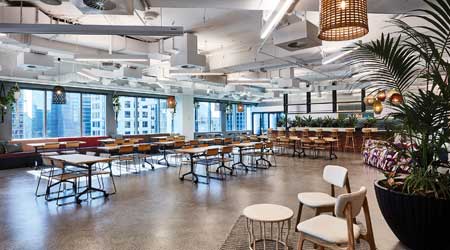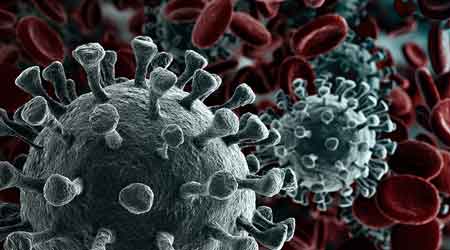6 Facility Strategies to Prevent Coronavirus Spread
As facilities slowly begin to reopen, consider these important infection control tips to prevent the spread of the virus.
While it is too early to fully measure the global impact of the coronavirus, it is safe to assume that how facilities conduct day-to-day business will change. There will be a new norm. People will view the person coughing next to them in the elevator differently. The sniffling and sneezing cubicle neighbor — is it allergies or the flu? While facility departments cannot prevent sick people from coming into their buildings, they can implement measures that mitigate risk and bring peace of mind so that workers and patrons can breathe more easily.
These measures make sense even if the COVID-19 pandemic was a once a century event. The Centers for Disease Control and Prevention (CDC) estimates that, since 2010, from 9 million to 45 million people in the United States have contracted the flu each year, with death tolls estimated to be as high as 61,000. Depending upon the severity of the flu season, the economic impact to the United States could exceed $87 billion with 65 percent of those costs the result of lost productivity and revenue — that’s just shy of half a percent of the U.S. gross domestic product; to translate, the flu would wipe out Amazon’s 2019 fourth quarter revenue. Given those numbers, the common flu alone provides significant fiscal justification to improve and invest in facility management practices and operations in six areas.
1. Cleaning practices
Knowing that pathogens can remain viable on surfaces for days, a practical first line of defense is comprehensive cleaning practices employed at the facility. CDC recommends routine cleaning of frequently touched surfaces, such as tables, doorknobs, light switches, and faucets with Environmental Protection Agency (EPA)-registered disinfectants that are appropriate for the surface; facility managers may want to potentially increase cleaning frequency during the flu season, which runs from October through May. Common spaces, such as restrooms, breakrooms, conference rooms, etc., should take high priority.
Building occupants should be encouraged to clean their personal workspace with approved disinfectants, as provided by facility or environmental, health, and safety departments.
Note that cleaners merely remove dirt and grime, but do not necessarily kill bacteria or viruses; EPA provides a list of registered disinfecting products, contact time, and targeted pathogen.
2. Education and awareness
The COVID-19 pandemic has drastically increased awareness of the need for handwashing, covering coughs, and isolating oneself when symptoms are present. Educational signage should be displayed, with occasional email reminders, to keep this awareness at the forefront of everyone’s mind — especially during the flu season.
Facilities can take extra steps by expanding the location of sanitation stations, providing appropriate masks, and ensuring occupants have access to approved disinfectant wipes.
Building systems and operations present many opportunities to reduce the risk of infection. Bacteria, mold spores, and viruses, such as COVID-19, can remain airborne for hours. Thus, beyond surface cleaning, facilities should explore these other options for reducing the level of infection-causing agents in the air.
3. Positive building pressure
The first step in delivering healthy indoor air quality is to properly balance the building so that it maintains positive pressure versus outside. This will mitigate moisture and air infiltration and prevent related contaminants from entering via uncontrolled pathways.
To achieve that goal, it’s important to ensure that the facility is airtight. Buildings should be properly commissioned and balanced by qualified providers after any construction that affects the exterior or changes the air or water (HVAC) distribution. Additionally, it is recommended that recommissioning occur every three to five years with some TAB (test/adjust/balance) measurements sampled. This step will ensure the facility and its systems continue to efficiently operate as designed.
Building pressure should be monitored and trended via the building automation system to confirm it remains within limits.
4. Relative humidity
While it is difficult to directly control, maintaining satisfactory relative humidity levels can play a key role in pulling dust, pollen, and mold spores out of occupied space.Lower humidity levels allow harmful molecules to stay airborne and to easily transfer from space to space.
Relative humidity of 40 to 60 percent has been shown to help inactivate the flu virus, and it improves the human body’s defense system against infection. It also helps to improve the rate at which viruses settle out of the air.
Ideally, humidification systems (e.g., steam injection) could be installed in air handler units, especially in drier climates; however, this can be cost prohibitive. Without adding humidification to the supply streams, relative humidity might be controlled by managing the mix of outside air and return air; of course, minimum outside air requirements must be maintained, as well as satisfactory filtration. This approach draws a facility closer to monitoring and controlling enthalpy versus dry bulb temperature, which does require more programming of the building automation system.
5. Outside air
Multiple studies have shown the positive impact of increased outside air on occupant health and productivity. For example, a study funded by United Technologies found that doubling ventilation rates doubled cognitive function test scores and resulted in fewer sick days.

(Perform an engineering analysis to determine if a facility’s air distribution system can accommodate the increased head loss from upgraded filtration levels.)
EPA states: “Control of pollutants at the source is the most effective strategy for maintaining clean indoor air. Control or mitigation of all sources, however, is not always possible or practical. Ventilation, either natural or mechanical, is the second most effective approach to providing acceptable indoor air.”
ASHRAE 62 establishes minimum air turnover rates; going beyond that minimum will significantly reduce harmful particles and improve overall building health.
6. Filtration and UVC
Improving air filtration is crucial to scrubbing and providing healthy indoor air. Media filters, which are predominant, can satisfy most filtering needs; however, they do have limitations. MERV (minimum efficiency reporting value) ratings as defined by ASHRAE provide varying degrees of filtration. For example, a filter with a MERV rating of 13 is highly efficient and can remove some bacteria and viruses. MERV 15 filters, which are normally deployed in hospital inpatient care spaces, can filter all bacteria. However, to filter all viruses, you would have to employ HEPA (High Efficiency Particulate Air) filters.
It is important to note that the higher the MERV rating, the higher the pressure drop across the filter bank. Thus, an engineering analysis would need to be performed to determine if a facility’s air distribution system can accommodate the increased head loss and to identify what changes are needed to upgrade filtration levels. The analysis must be an end-to-end evaluation from the air handler to the point of use (e.g., diffuser), accounting for all losses. Additionally, as the MERV rating goes up, so do the respective costs. Thus, filters with lower ratings should be installed as pre-filters — introducing more head loss. All that said, improving indoor air quality is not as simple as installing “better” filters.
As an alternative to media filters with high MERV ratings, UV-C air cleaners use ultraviolet C light to “degrade organic material and inactivate microorganisms,” according to an ASHRAE position document. ASHRAE also notes that UV-C or UVGI (ultraviolet germicidal irradiation), as it is sometimes called, is not a filter; thus, a media filter must be used in conjunction with UV-C. There are several variables at play in determining where to install such UV systems; facility managers should consult a qualified specialist and reference ASHRAE Standard 185 for more specifics.
The key with any filtration system is proper design, installation (including TAB), monitoring, and maintenance, replacing components as their effectiveness and efficiency wane.
John Rimer (john@fm360consulting.com), CFM, is president of FM360, LLC. In more than 20 years of facility management experience, he has implemented and managed facility programs for companies such as Intel, Microsoft, JP Morgan Chase, and Charles Schwab.
Related Topics:













